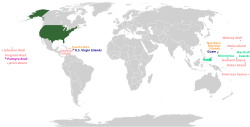
Territories of the United States
From Wikipedia, the free encyclopedia
Territories of the United States are sub-national administrative divisions overseen by the federal government of the United States. The various American territories differ from the U.S. states and Indian reservations as they are not sovereign entities.[note 2] In contrast, each state has a sovereignty separate from that of the federal government and each federally recognized Native American tribe possesses limited tribal sovereignty as a "dependent sovereign nation."[4] Territories are classified by incorporation and whether they have an "organized" government through an organic act passed by the Congress.[5] American territories are under American sovereignty and, consequently, may be treated as part of the United States proper in some ways and not others (i.e., territories belong to, but are not considered to be a part of, the United States).[6] Unincorporated territories in particular are not considered to be integral parts of the United States,[7] and the Constitution of the United States applies only partially in those territories.[8][9][5][10][11]
Territories of the United States | |
|---|---|
 Incorporated, unorganized territory
Unincorporated, organized territory
Unincorporated, unorganized territory | |
| Languages | English, Spanish, Carolinian, Chamorro, Samoan |
| Demonym(s) | American |
| Territories |
9 uninhabited 2 disputed |
| Leaders | |
| Joe Biden | |
| List | |
| Area | |
• Total | 22,294.19 km2 (8,607.83 sq mi) |
| Population | |
• 2020 census | 3,623,895[2][3] |
| Currency | United States dollar |
| Date format | mm/dd/yyyy (AD) |
| This article is part of a series on |
| Political divisions of the United States |
|---|
 |
| First level |
|
|
| Second level |
|
| Third level |
|
|
| Fourth level |
| Other areas |
|
|
|
United States portal |
The United States currently administers three[8][12] territories in the Caribbean Sea and eleven in the Pacific Ocean.[note 3][note 4] Five territories (American Samoa, Guam, the Northern Mariana Islands, Puerto Rico, and the U.S. Virgin Islands) are permanently inhabited, unincorporated territories; the other nine are small islands, atolls, and reefs with no native (or permanent) population. Of the nine, only one is classified as an incorporated territory (Palmyra Atoll). Two additional territories (Bajo Nuevo Bank and Serranilla Bank) are claimed by the United States but administered by Colombia.[9][14][15] Historically, territories were created to administer newly acquired land, and most eventually attained statehood.[16][17] The most recent territories to become U.S. states were Alaska on January 3, 1959, and Hawaii on August 21, 1959.[18] The Republic of the Philippines — along with the Federated States of Micronesia, the Republic of the Marshall Islands, and the Republic of Palau, which were administered as a U.N. trust territory, but sometimes grouped with U.S. territories — later became independent nations.[note 5]
Politically and economically, the territories are underdeveloped. Residents of United States territories cannot vote in United States presidential elections, and they have only non-voting representation in the United States Congress.[9] According to 2012 data, territorial telecommunications and other infrastructure are generally inferior to that of the continental United States and Hawaii.[19] Poverty rates are higher in the territories than in the states.[20][21]
.svg/125px-Flag_of_the_United_States_(DoS_ECA_Color_Standard).svg.png)